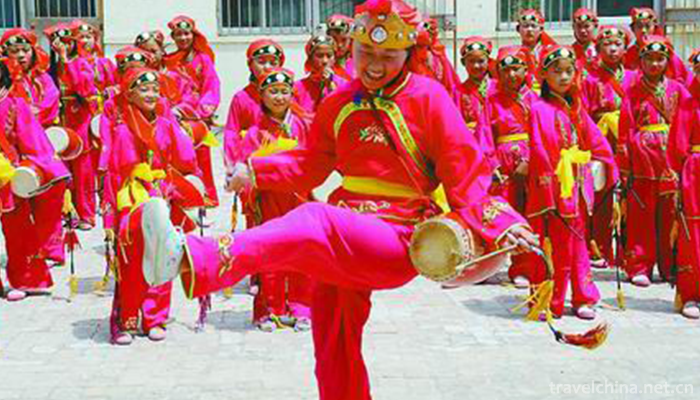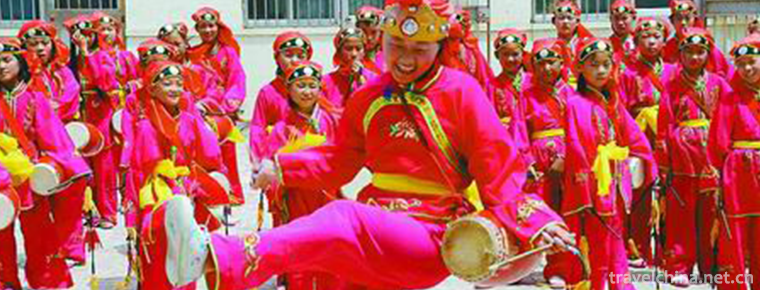Shandong Huagu
Shandong Huagu
Shandong Huagu is a traditional folk art form with Huagu as the main accompaniment instrument. It is also the only type of walking songs in Shandong folk art. Shandong Huagu is very good at expressing the short life stories of parents, that is, the so-called "needle and thread bamboo sticks". Shandong Huagu derives a variety of local operas, such as two-chord, four-level tune, five-tone opera, Liuqin opera, Maoqiang opera, Yiguo opera, etc. It is the direct mother of many kinds of operas and has had an important impact on the development of Shandong local operas. In 2006, it was listed in the first batch of intangible cultural heritage in Shandong Province.
On November 11, 2014, Shandong Huagu was listed in the fourth batch of national intangible cultural heritage list with the approval of the State Council.
Historical Origin
Shandong Huagu is very good at expressing the short life stories of parents, that is, the so-called "needle and thread bamboo sticks". Since Yuan and Ming Dynasty, because of the interesting language and many flirtatious content, it has often been banned as "lewd words" by the government, but it is popular among the people. In the southwestern part of Shandong Province, there is a folk song: "Flower Drum enters Zhuangzhuang, family does not drink soup (dialect is dinner)." It means that every household goes to listen to flower drums, and everyone is so fascinated that they don't even eat dinner.
In the Southern Song Dynasty, there were records of flower drums in Shandong Province. A survey of Shandong Quyi artists registered in the 1950s shows that in the mid-Qing Dynasty, Huagu was active in the border areas of Shandong, Jiangsu, Henan and Anhui provinces. Among them, the popular flower drums in Shandong can be roughly divided into three routes. They develop northward and eastward with the southwest of Shandong as the center. They are all artistic forms such as folk ditties and dances. They absorb and combine with each other to form different artistic styles, resulting in a variety of local operas, such as two-chord, four-level tune, five-tone opera, Liuqin opera, Maoqiang opera and one-hook.
The popular "South Road" of Shandong Huagu in the southwest of Shandong Province, such as Heze, eventually evolved into two kinds of operas in the late Qing and Xianfeng dynasties. However, the flower drum, a form of rap and singing based on Heze dialect, has not disappeared, and has always been in line with the performance of traditional operas. It is one of the important forms of cultural entertainment for the people of Heze for a long time, and still retains its original flavor.
representative figure
Referring to Shandong Huagu, we can not but mention the late artist Du Xueshi's poems. Reporters in the interview, the most heard is his artistic name "Black Cloud". Du Xueshi (1900-1976), Ding Tao Ren, 12-year-old Baipei County flower drum artist "half bowl of honey" as a teacher, the main role, 18-year-old in the southwest of Shandong Province, emerging, often singing in the bookstore of Jining Tushan miscellaneous eight places, or four townships to gather in the stalls.
The performances such as Chen Sanliang Climbing Hall, Li Yanming, Flower Hall Club and Jizhou Visit were welcomed by the audience, especially young women. His voice is clear and his performance is moving. Because of his dark skin and excellent art, the audience gives the sign "Black Cloud" intimately. In the southwest of Shandong Province, there is a saying that "no one can suppress the black clouds when they come from the South or the north".
Du Xueshi married Lin Shuying during his stay in Jining. Lin Shuying studied art with her husband and renamed Du Xuelian after her marriage. A few years later, she also gained a great reputation and became one of the "four famous figures" in the Huagu circles of Lu, Su, Henan and Anhui (Wang Guifang, Guo Zhenfang, Yin Yanxi and Du Xuelian).
Husband and wife in Heze, Jining and other places widely accepted disciples, "Black Cloud Class" performance more active. Later, Huagu Ban was banned on the charge of obstructing weathering, forcing "Black Cloud" and Huagu artists Xiaolanzi and Dalanzi from northern Jiangsu to form Huagu Ban Club, which moved to Shanghai Jockey Ground for performances, then transferred to Fuyang, Jieshou and Yanzhou, Tai'an, Liaocheng, Zibo, Dezhou and Jinan, renamed "Shandong Old Tune", "Shandong Dry Bang Bang", "Huagu Clove" and "Laobang Zibo". Continue to perform. When performing in Jinan, he once sang opposite stage with "Fresh Cherry" in Nangangzi. During the performance in the Grand View Garden, the audience presented the plaque of "Yiguan North China".
Audience group
Many villages in Yuncheng have flower and drum artists. Every year in the fallow season, flower and drum clubs can be seen in county towns and larger towns. So far, people there still love flower and drum.
Shandong Huagu does not have a strict pedigree of inheritance. Most of them are enthusiasts who teach by mouth and heart. Even if they succeed, few of them become professional actors. The scattered groups in leisure time do not re-inherit. They can sing together. Only a few professional performance clubs have a slightly standardized relationship of inheritance. Since the 1990s, with the death of old artists, the inheritance of flower drums is not continuous, many relatively active folk classes are declining, and the performances spontaneously organized by farmers are becoming less and less. In order to protect this intangible cultural heritage, the staff of the Museum of Art specially organized several local folk artists to perform in order to record audio and video materials for preservation.
Wang Fengjie, a 51-year-old villager in Dingbei Village, studied art with Xie Ruquan, a famous flower drum artist in Yuncheng. He recalled: "My master's Dream of Little Two Sisters is so tasty that people in nearby villages would like to listen to it and follow it." Often from the afternoon to the evening, young and old listen fascinated and forget to go home for soup. Miao Qingsuo, 32, and Peng Xianrong, 35, are husband and wife from the Miaohutong village of Yuhuangmiao Town, Yuncheng. Miao Qingsuo said that he sang as a child and followed the village's flower and drum troupe around Heze.
A man and a woman singing and dancing in pairs, rap, is the main performance form of Shandong Huagu. Since the Yuan and Ming Dynasties, flower drums have often been banned as "obscene lyrics" by the government, but they are deeply loved by the people in the folk.
Representative Works and Their Inheritance Significance
Shandong Huagu is very good at expressing the short life stories of parents, that is, the so-called "needle and thread bamboo slips", which can be seen from its basic repertoire "the Eight Old Books" - Toutang, Ertang, Succession of Wife, Huawall, Big Curtain, Second Curtain, Huajiao and Holding Brand. Most of the 140 pieces of Shandong Huagu music that have been preserved so far reflect the love stories of men and women and the moral and ethical stories of families. The repertoires that often appear are: Goodman Duan, Black Donkey Duan, Wang Po Cursing Chicken, An'an Sending Rice, Wang Xiao Catching Foot, Wang Gang Painting Temple, Zhu Maichen Divorcing Wife, Qiu Daguan, Wang Erjie Cutting Vegetables, Painting Shoes, etc. They are full of interest in life, and their lyrics are popular and vivid. They have a variety of studies, such as dialectology, sociology, Folklore and local culture. Value. Its words are mostly seven-character sentences and cross sentences, which seem to lack standardization. Only by careful study can the artists show their wisdom and achievements in using language, which shows the unique charm of folk art.


-
1.National Palace Museum Taipei
Taipei national the Imperial Palace Museum, also known as the Taipei the Imperial Palace and Zhongshan Museum. It is one of the three major museums in China and one of the largest comprehensive museum
Time 2018-10-12 -
2.Martial Art
Wushu is a technology inherited from ancient military wars. Martial arts can strengthen the body and defend the enemy
Time 2018-11-13 -
3.Yanoda Tropical Rainforest Scenic Area
Yanuoda Tropical Rainforest Scenic Area is the only tropical rainforest located at 18 degrees north latitude in China. It is the concentration of five tropical rainforests in Hainan Island
Time 2018-12-12 -
4.Shanghai Museum of Natural History
The Shanghai Museum of Nature (Shanghai Science and Technology Museum Natural Branch) is one of the largest natural museums in China. Located in the center of Shanghai, Address: 260 Yan'an East Road,
Time 2018-12-15 -
5.Jinan International Park Expo
Jinan International Park Expo Park covers an area of 5176 Mu and is located in Jinan University Science Park. The Lake area is 1440 mu. It is the largest land park in China
Time 2019-01-21 -
6.Traditional Cotton Textile Techniques
Chinese traditional textile technology has a long history. Since cotton was introduced from India in the 7th century, Chinese textile industry has changed from linen to cotton.
Time 2019-04-19 -
7.Hangzhou Reviews
Hangzhou commentary originated from the Southern Song Dynasty, and has a history of 800 years. It is the most characteristic local traditional folk art in Hangzhou, Zhejiang Province.
Time 2019-05-02 -
8.Gongs and drums
Gong and drum zaju, also known as "zaju of Gong and drum" and "long Yan zaju", is one of the local traditional dramas in Shanxi Province and Henan Province and one of the national
Time 2019-05-15 -
9.She Costume
She nationality's men and women's clothing is basically the same as that of the local Han people. However, the She ethnic costumes in Fujian and Zhejiang provinces with relatively concentrated populat
Time 2019-06-14 -
10.Line lion
Line lion is a local traditional lion dance in Ningde City, Fujian Province. Shiqiaotou village's line lion nine lions map originated from the celebration of the Lantern Festival on the 15th day of th
Time 2019-07-03 -
11.University of International Relations
University of International Relations (University of International Relations), referred to as "Guo Guan", is located in the western suburb of Beijing. Ministry of Education of the People's R
Time 2019-09-22 -
12.Hefei University Of Technology
HeFei University of Technology (Hefei University of Technology) is directly under the Ministry of education of People's Republic of China. National Key Universities By Ministry of Education , Anhui Pr
Time 2019-11-11